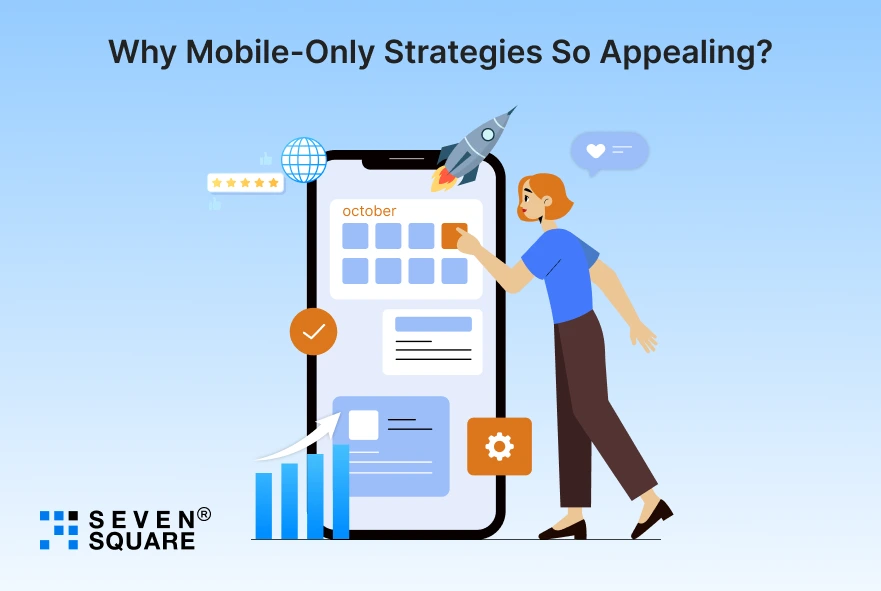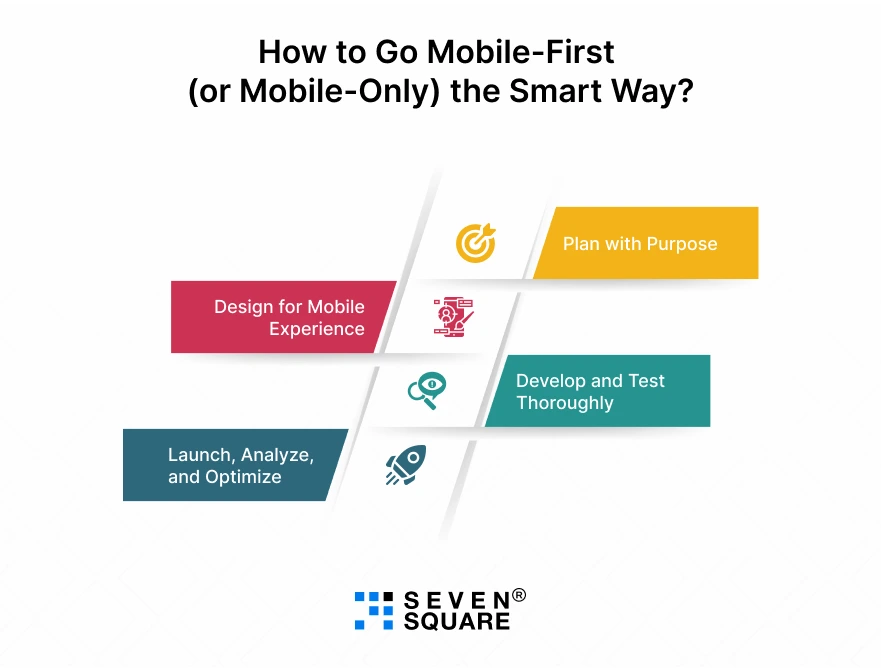Do you know that more than 60% of all web traffic now comes from mobile devices?
That number is a wake-up call for businesses everywhere. Your customer’s first impression often happens on a mobile screen, not a desktop.
Whether they’re shopping, booking services, or scrolling through content, your business has to meet them where they are on mobile.
That’s where the big question appears: Should your brand go mobile-first or mobile-only?
Many companies succeed (and struggle) based on this very decision. The right approach can boost visibility, improve customer experience, & even double your conversions.
The wrong one can make your online presence disappear among the competitors.
In this blog, we’ll try to explain the difference between mobile-first vs mobile-only.
You can understand their pros and cons, and help you choose the mobile-first strategy (or mobile-only approach) that is best for your business goals.
What Do “Mobile-First” and “Mobile-Only” Mean?
Understanding the difference between mobile-first and mobile-only strategies is the key to making the right choice.
What is Mobile-First Design?
- A mobile-first design means you design your website or app for mobile devices first, then adapt it for larger screens like tablets or desktops.
- This strategy focuses on speed, simplicity, and user experience, ensuring your website loads fast and looks great on any screen.
- Think of Amazon or Airbnb, as they started by focusing on a strong mobile experience, but still work smoothly across all devices.
What is a Mobile-Only Strategy?
- A mobile-only strategy means you design your product exclusively for mobile devices. There’s no desktop version & the entire experience lives within your app.
- Examples like Instagram, TikTok, and Clubhouse are platforms built purely for the mobile world.
- This approach allows brands to create more personalized, engaging, and app-driven user experiences, but it also means you’re focusing only on one platform.
Tip: You can consider both like this:
- Mobile-First: We design for mobile, but support all devices.
- Mobile-Only: We live entirely on mobile.
We help businesses to identify which approach is best for their audience.
Some clients benefit from a mobile-first website that drives organic traffic, while others see explosive growth with a mobile-only app strategy focused on engagement.
Learn more about Social Voice Apps like Ten Ten.
How Can a Mobile-First Approach Benefit Your Business?
Google now uses mobile-first indexing, which means your website’s mobile version decides how it ranks on Google.
If your mobile experience isn’t optimized, your performance suffers, no matter how beautiful your desktop site looks.
That’s why mobile-first design has become the top priority for every modern business in 2025. It’s about offering the best user experience for mobile users.
Why Mobile-First Matters Now?
- Most customers browse, compare, and buy directly from their phones.
- Mobile-first websites load faster, improving engagement and retention.
- A clean, user-focused UI/UX makes navigation easy and builds trust.
- Mobile-first websites often outperform desktop-heavy websites in conversions and rankings.
Is the Mobile-Only Strategy the Future for App-Driven Businesses?
A mobile-only strategy is bold, focused, and all-in.
It means your business chooses to exist entirely on mobile devices & offering users an app-based experience that’s personal and always within reach.
We often see startups and digital-first brands choosing this route to build deeper engagement and brand loyalty.
Unlike websites that try to serve both desktop and mobile users, a mobile-only app gives you full control over the user experience (UX); every button, every screen, every push notification is designed for the mobile user.
Why Mobile-Only Strategies So Appealing?

- App Exclusivity: Users feel special when your app gives them access to features not available elsewhere.
- High Engagement: Push notifications, instant updates, and in-app personalization keep users coming back.
- Better Retention: Mobile apps stay right on a user’s home screen, making your brand part of their daily routine.
- Faster Performance: Native apps often load faster and work smoothly than mobile websites
What Are the Industries That Thrive On a Mobile-Only Model?
Few industries have seen incredible growth with a mobile-only strategy, like:
- Fintech: Mobile banking and payment apps like Revolut, Paytm, and Cash App.
- Social Apps: Instagram, TikTok, and Clubhouse, all mobile-first at first, but mobile-only in function.
- On-Demand Services: Food delivery, ride-hailing, and grocery apps thrive entirely on mobile.
If your audience relies heavily on desktop browsing, going all-in on mobile might limit reach. Choosing wisely is the key.
Mobile-First vs Mobile-Only: What’s the Real Difference?
When deciding between mobile-first vs mobile-only, it’s important to understand how they are different in design, cost, and long-term benefits.
We help businesses evaluate both strategies carefully, because your choice affects everything from visibility to user accessibility.
Mobile-First vs Mobile-Only Comparison Table
| Criteria | Mobile-First Strategy | Mobile-Only Strategy |
| Target Audience | Users across devices. (mobile + desktop) | Purely mobile users. |
| Development Cost | Lower (one responsive website) | Higher (separate app build) |
| Maintenance | Easier to manage across all devices. | Requires app updates and platform maintenance. |
| Accessibility | High as users can access via any browser. | Limited as app download required. |
| Performance | Excellent on all screens. | Best on mobile but unavailable elsewhere. |
When Mobile-First Wins?
Choose mobile-first when:
- You want search engine visibility and organic traffic.
- Your users access your website across devices.
- You want to keep costs manageable.
When Mobile-Only Wins?
Choose mobile-only when:
- Your brand depends on user engagement, personalization, and loyalty.
- You want native app speed and interactivity.
- You serve an audience that lives entirely on mobile (like social, fintech, or delivery users).
Which Mobile Strategy Is Right for Your Business Type?
Every business is different, so the right choice depends on your goals, audience, and growth plans.
Here’s a simple decision framework we use to guide clients.
Decision Checklist
- Focused on discoverability? Go Mobile-First.
- Aiming for app retention and engagement? Go Mobile-Only.
- Need both visibility and loyalty? Choose a hybrid approach.
Best Choice for Each Business Type
1. Ecommerce Brands
- If you run an online store, a mobile-first strategy is often better.
- Most customers find products through Google searches, so you need a responsive website first.
- Later, you can launch a mobile-only shopping app for loyal buyers and better retention.
2. SaaS Startups
- For SaaS platforms, the best route often starts with a mobile-first web app that scales to mobile devices.
- Once your user base grows, developing a mobile-only companion app can improve convenience and engagement.
3. Local Service Businesses
- For small businesses, a mobile-first strategy works best initially, but it’s affordable & accessible.
- Later, adding a mobile-only app can help manage bookings, payments, or loyalty programs more easily.
How to Go Mobile-First (or Mobile-Only) the Smart Way?

Here’s how to implement a mobile-first strategy (or mobile-only app) the smart way:
Step 1: Plan with Purpose
- Define your business goals and audience clearly.
- Decide if you need a mobile-first website or a mobile-only app.
- Identify user journeys, how will users browse, buy, or interact on mobile?
Step 2: Design for Mobile Experience
- Keep it simple, fast, and interactive.
- Follow mobile UX best practices:
- Large buttons for touch screens
- Minimal text and clean layouts
- Prioritize speed and readability
- Ensure your design is responsive, adapting perfectly to all screen sizes.
Step 3: Develop and Test Thoroughly
- Build using modern frameworks like React Native, Flutter, or Next.js (depending on your path).
- Test across devices for performance, loading speed, and accessibility.
- Also optimize titles, meta descriptions, and images.
Step 4: Launch, Analyze, and Optimize
- After launch, track user behavior and retention.
- Continuously improve UX and fix pain points.
- Monitor Google’s mobile-first indexing for growth.
Why Choose Us to Build Your Perfect Mobile Experience?
Whether your business needs a mobile-first website or a mobile-only app, our approach ensures your product is fast, responsive, and ready for growth.
- We specialize in both mobile-first development (responsive websites that work perfectly across devices) and mobile-only strategies for startups (exclusive apps that deliver deep engagement).
- From UI/UX design to mobile performance optimization, we ensure your product loads quickly and delivers a smooth user experience.
- Whether you’re launching your first startup or upgrading an enterprise solution, we create mobile solutions that grow with your business.
- Communication is our strength. You’ll stay updated through every step, from design to launch, with real-time insights and transparent progress reports.
Your Strategy Defines Your Success
- Both mobile-first and mobile-only strategies have their strengths.
- A mobile-first strategy focuses on accessibility and scalability, which makes it ideal for growing businesses.
- Meanwhile, a mobile-only strategy emphasizes exclusive user experiences and deep engagement, perfect for app-driven brands.
- We believe that your mobile strategy defines your business growth.
- Whether you choose mobile-first, mobile-only, or a hybrid approach, what truly matters is understanding your users and building with purpose.
FAQs
- Mobile-first design focuses on building a responsive website that looks perfect on mobile screens first and then scales up for desktop.
- Mobile-only, on the other hand, means building an app or platform exclusively for mobile users.
- For most small businesses, a mobile-first strategy works best as it’s cost-effective and helps reach customers on all devices.
- However, mobile-only can be ideal for app-centric startups like delivery or fintech businesses.
- Yes. Mobile-only apps can offer deeper engagement & personalization, especially in sectors like fintech, fitness, and social networking.
- But it requires a strong user acquisition strategy and consistent updates to stay relevant.
- The cost depends on your business size and goals.
- A mobile-first website typically costs less than a full-scale mobile-only app, but both can deliver strong ROI when built strategically.
- We help you find the most efficient path to go mobile without compromising quality or speed.